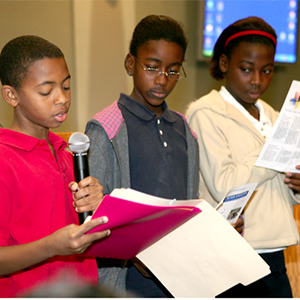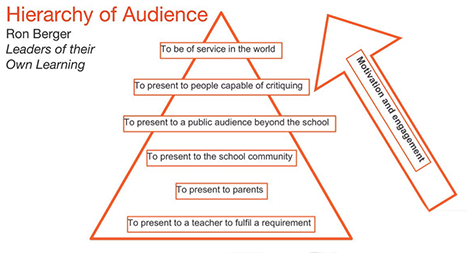
Due to the increased use of Project Based Learning, as well as changes in standards, instruction, and technology, students are doing more presentations.
Some of our students’ presentations are for their peers. Others are for more public audiences like parents, community members and business leaders. And some are shared globally and digitally through social media.
Having all students consistently present their work is a good idea. However, we know all students need support in improving their skills as presenters (see this guest blog post by Erik Palmer on the topic). Presentation rubrics are a great start, but we actually need to make the presentation skills part of our curriculum. Students need to learn about design, audience, messaging, branding, and storytelling at the outset of a project and not just as an afterthought. Stories are how the most inspirational or motivational speakers present ideas, initiate innovation and ultimately get people to think. Need proof? Watch at any Ted Talk and analyze the structure of the presentation. They are narratives with beginnings, middles and ends with characters, conflict and resolution. Students need to master the art of informal and formal storytelling.
How can schools include presentations as part of their curriculum and give all students multiple opportunities to master those skills? Before we address the what and how, let’s explain the why.
Why Are Presentations & Presentation Skills at the Heart of PBL and 21st Century Learning?
Pedagogy. PBL speaks directly to the idea of student presentations when it asks work to be public. And ultimately, public implies beyond the classroom. Presentations allow us to demonstrate that we have learned content, but also that we have applied that content to something relevant, personal and sustained.
Skills. Communication has always been foundational in terms of academic and professional success. But in this digitized, globalized, and personalized economy, it’s more important than ever. Employers identify this as a foundational competency—more and more people are even being asked to give a presentation as part of a job interview.
Standards. Presentation knowledge and skills are now part of new state standards. See the CCSS Speaking and Listening Standards as an example. You can also find an emphasis on presentation in the technology standards as well.
Assessment. We now use performance assessments to measure student progress toward learning outcomes. Presentations are performance assessments. More schools are asking students to defend their learning and share their portfolios. When students can articulate what they learned, why it’s significant and how it’s applied, they are truly demonstrating critical thinking and depth of knowledge.
Personal Branding. We are moving into a new economy where experts predict that 40%-50% of our future work will be contracted or independent work, in what’s known as the “gig” economy. And even if we are not completely dependent on the gig economy, we're all going to need to know how to brand ourselves. When we don’t work for one employer, company or organization, we have to continually seek to both find and secure a job. In addition to our technical and career skills, we will have to possess the ability to articulate why we’re the right person for that gig. We need to know who we are, what makes our story unique, and how we can share that.
How Can We Advance Our Students’ Presentation Skills Through the Curriculum?
Delivery. Yes, delivery and execution of a presentation are important. However, we can’t put delivery on the rubric and expect mastery. We need to model, practice, and perform—then repeat. As students become more involved and connected to their work, as well as master the other elements, delivery will improve too.
Visual Design Skills. This is the often neglected dark side of presentations. We all know what bad presentation visuals look like, but we often don’t teach what a good ones look like. We need to make this a large part of the presentation curriculum. We have access to great digital tools, but are not well versed in design. Teachers don’t need to be experts, but rather look for the models and expose students to resources. The professionals use things like the Duarte presentation resources, so why shouldn’t our classrooms?
Storytelling. Like all skills, there is an art to storytelling. For example, all students should study things like Joseph Campbell’s “Hero’s Journey” (link no longer available) as a means to see how to craft a story. Students need to learn that presentations are well-prepared and customized stories hand crafted by the presenter for maximum impact. We don’t just slap slides together with words and content. We start with the big ideas and learn how to communicate those with specifics meant to elicit, educate and illuminate. Students could learn from watching some the most popular Ted Talks.
Audience Analysis. All of us can benefit of understanding who is in the room (face-to-face or digital). We can learn how to cater and customize our message, as well as our our language, our visuals, and our style. This will be important in all public venues and also enhance how presentations skills translate into interviewing/employability skills. The standards address the need for students to alter or customize their message for their specific audience.

From Leaders of Their Own Learning (Wiley 2014) by Ron Berger
Creating Opportunities. We need to continue to expand student opportunities to present publicly. Yes, students can present to peers in their classes. But that’s really the beginning and the novice level (as shown on Ron Berger’s chart, above). To achieve mastery, we need to repeatedly set up more public opportunities. Schools can host and facilitate student showcases and exhibitions. We can connect our students and their work to board meetings, community groups, business leaders, website, social media and more. Schools can create and facilitate portfolio presentations, senior projects, defense of learning events, common digital portfolios, interviews and internships, competitions and contests, 20Time projects--and other endless presentation opportunities for all students.
Follow Michael Niehioff on Twitter: @mwniehoff
and see his website michaelniehoff.com.

